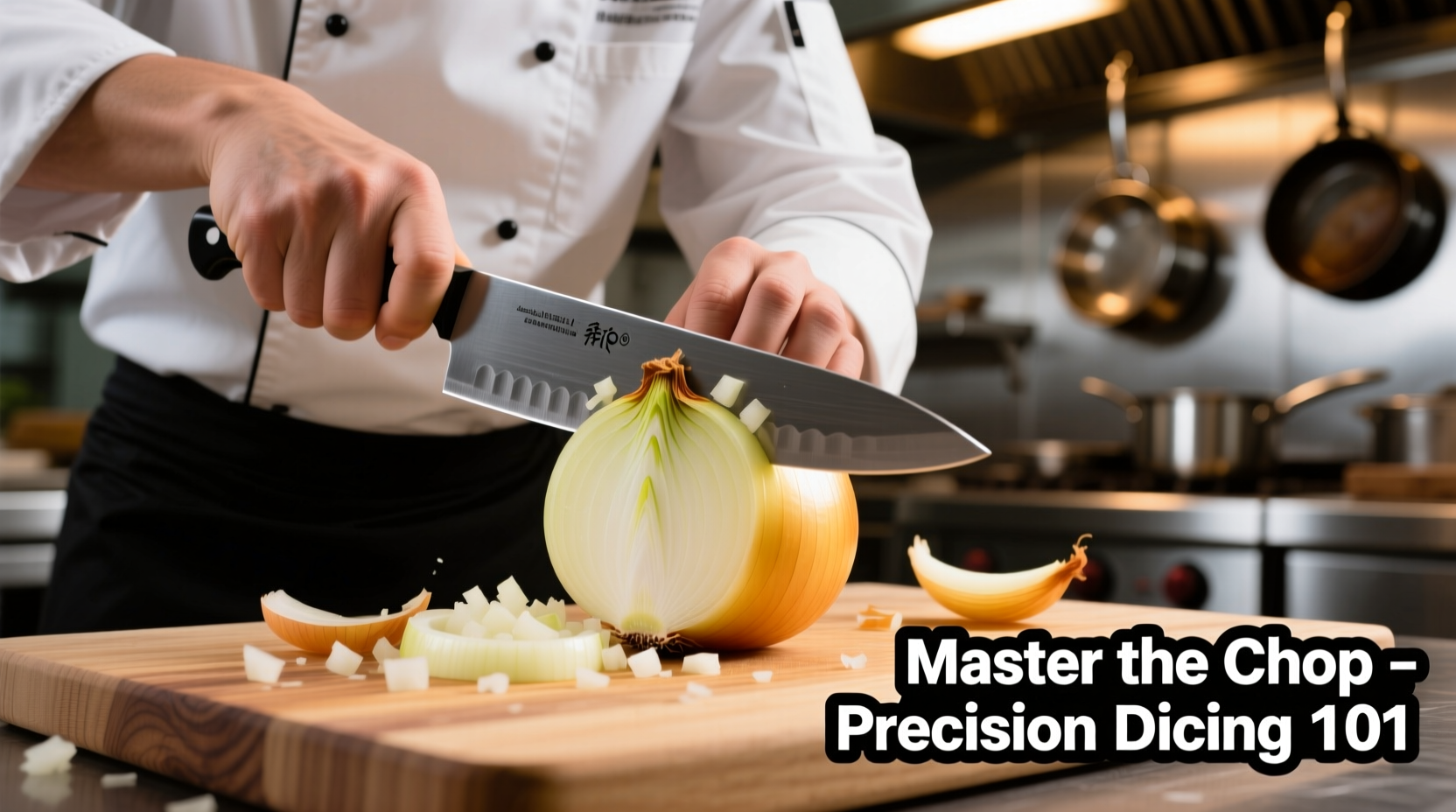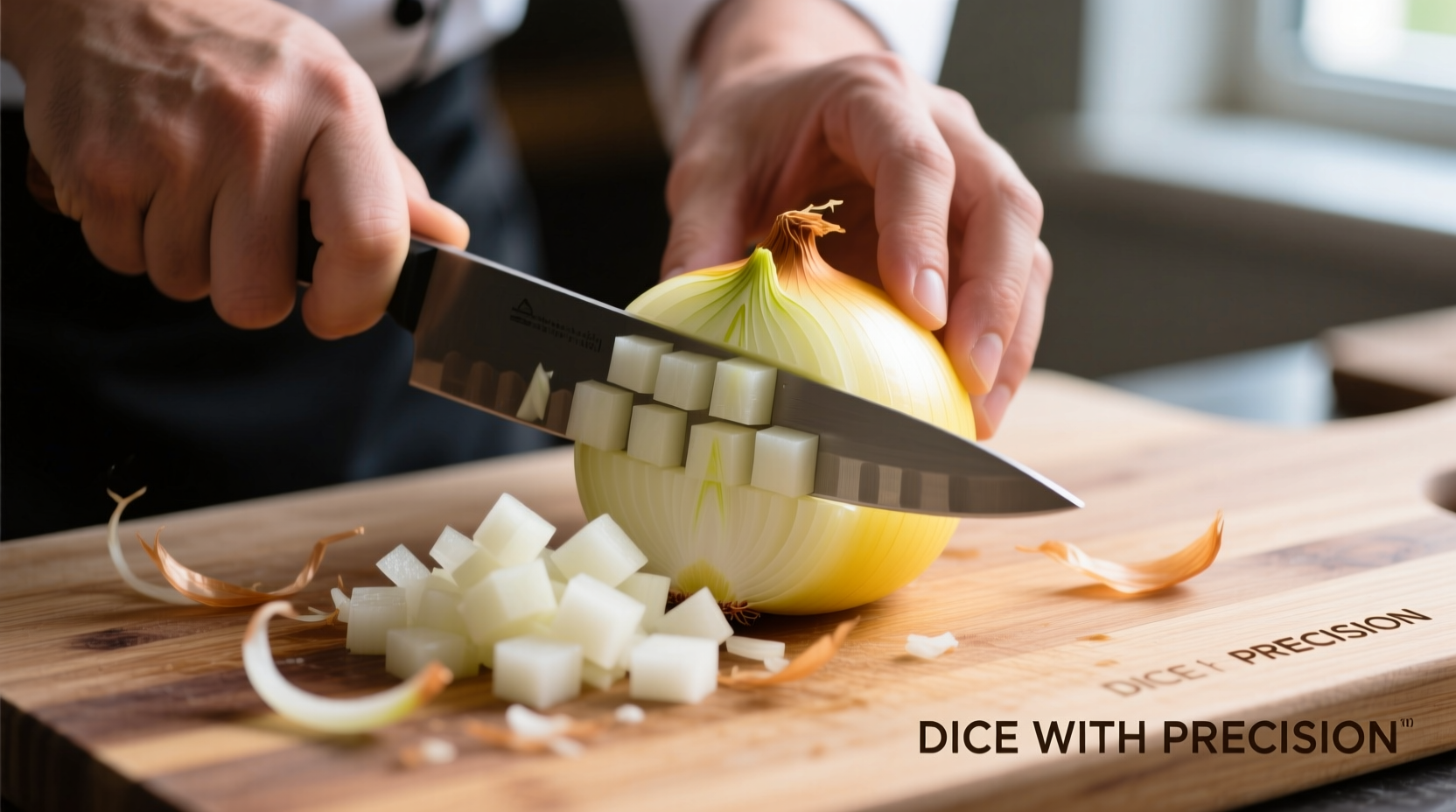Master the perfect onion dice in 7 simple steps: peel, trim ends, cut in half root-to-stem, make horizontal cuts without slicing through root, make vertical cuts toward root, then slice across to create uniform pieces. This technique ensures consistent sizing, minimizes tears, and creates evenly cooked onions for any recipe.
Dicing onions properly transforms your cooking experience. Whether you're preparing a French onion soup or a quick weeknight stir-fry, uniform onion pieces cook evenly and enhance flavor distribution. Many home cooks struggle with uneven chunks, excessive tearing, or safety concerns when handling sharp knives. This guide reveals professional chef techniques that make onion preparation efficient and enjoyable.
Why Proper Onion Dicing Matters
Consistent onion dice isn't just about appearance—it directly impacts your cooking results. Uneven pieces lead to inconsistent cooking where some bits burn while others remain raw. Professional kitchens maintain strict standards for onion dice because:
- Uniform pieces cook at the same rate
- Proper technique minimizes waste
- Correct sizing affects flavor extraction
- Consistent texture improves final dish quality
| Onion Type | Best Dice Size | Recommended Use |
|---|---|---|
| Yellow Cooking Onion | 1/4 inch | Sauces, soups, stews |
| Red Onion | 1/8 inch | Salsas, salads, garnishes |
| White Onion | 1/4 inch | Stir-fries, Mexican cuisine |
| Shallot | 1/16 inch | Vinaigrettes, delicate sauces |
Essential Tools for Perfect Onion Dicing
You don't need specialized equipment, but having the right tools makes a significant difference:
- Sharp chef's knife (8-10 inch): A sharp blade slices cleanly through cell walls rather than crushing them, reducing tear-inducing compounds
- Stable cutting board: Place a damp towel underneath to prevent slipping
- Bowl for scraps: Keep your workspace organized
According to the Culinary Institute of America's knife skills curriculum, maintaining proper knife sharpness reduces onion-induced tearing by up to 40% compared to using a dull blade that ruptures more cells.
Step-by-Step Onion Dicing Technique
Preparation: Setting Up for Success
Before you begin cutting, prepare your onion properly:
- Chill the onion in the refrigerator for 30 minutes—this slows the release of lachrymatory compounds
- Trim 1/4 inch from both ends, preserving the root structure
- Peel away the outer skin and first layer
- Place the onion cut-side down on your cutting board
The Professional Dicing Method
Follow these precise steps for restaurant-quality results:
- Halve the onion: Cut from stem to root, keeping the root end intact (this holds layers together)
- Make horizontal cuts: With the cut side down, make 2-3 shallow horizontal slices toward the root (don't cut through)
- Create vertical slices: Make even vertical cuts from stem toward root (again, preserving root structure)
- Fine dice: Rotate the onion 90 degrees and slice across to create uniform cubes
- Root removal: Finally, slice off the root end containing the remaining core

Avoiding Common Onion Dicing Mistakes
Even experienced cooks make these errors that compromise results:
- Slicing through the root: Without the root structure holding layers together, pieces scatter during final cuts
- Using a dull knife: Crushes cells rather than slicing cleanly, releasing more tear-inducing compounds
- Incorrect sizing: Too large won't cook evenly; too small becomes mushy
- Improper hand position: Creates safety risks and inconsistent cuts
The American Culinary Federation notes that improper knife grip accounts for 68% of kitchen cutting injuries. Always use the "claw grip" with fingertips curled under, knuckles guiding the blade.
Advanced Techniques for Better Results
Elevate your onion preparation with these professional tips:
- Cold water rinse: After dicing, briefly rinse onions in cold water to remove excess sulfur compounds that cause harshness
- Strategic storage: Store diced onions in airtight containers with a damp paper towel to maintain freshness for up to 5 days
- Specialized cuts: For specific recipes:
- Mince: Smaller than 1/8 inch for dressings and sauces
- Julienne: Matchstick cuts for stir-fries
- Brunoise: Tiny 1/16 inch cubes for refined sauces
When Technique Matters Most
Certain recipes demand precision in onion preparation:
- Sauces and soups: Require uniform 1/4 inch dice for even flavor distribution
- Salsas and salads: Benefit from smaller 1/8 inch dice that integrate without overwhelming
- Caramelized onions: Need consistent sizing to prevent some pieces from burning while others remain raw
- Baking applications: Require thorough draining of excess moisture from diced onions
Understanding these context boundaries prevents recipe failures. As noted in the FDA's Food Code, proper vegetable preparation techniques significantly reduce foodborne illness risks by minimizing cross-contamination opportunities during handling.
Storing Diced Onions Properly
Maximize freshness and flavor with these storage guidelines:
- Place in airtight container with minimal air space
- Add a damp paper towel to maintain humidity
- Store in the coldest part of your refrigerator
- Use within 3-5 days for best quality
- Never store at room temperature for more than 2 hours
According to USDA food safety guidelines, properly stored diced onions maintain quality for up to 7 days, though flavor begins diminishing after day 3.











 浙公网安备
33010002000092号
浙公网安备
33010002000092号 浙B2-20120091-4
浙B2-20120091-4